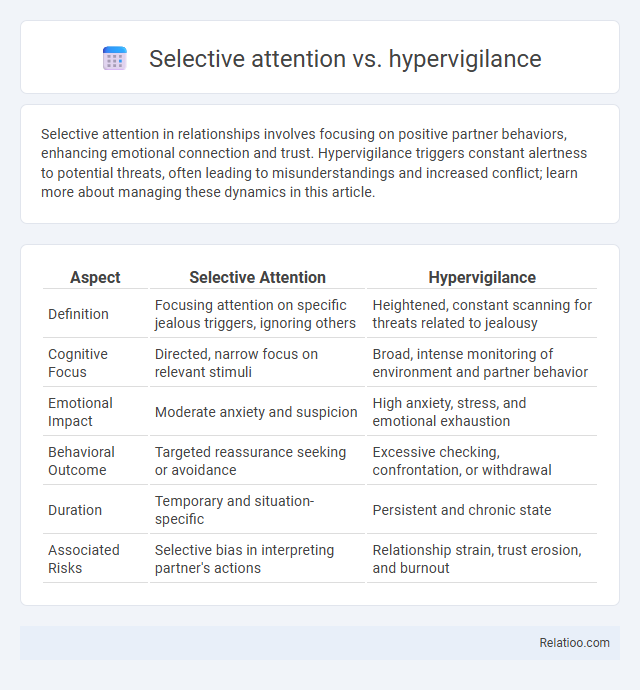Selective attention in relationships involves focusing on positive partner behaviors, enhancing emotional connection and trust. Hypervigilance triggers constant alertness to potential threats, often leading to misunderstandings and increased conflict; learn more about managing these dynamics in this article.
Table of Comparison
| Aspect | Selective Attention | Hypervigilance |
|---|---|---|
| Definition | Focusing attention on specific jealous triggers, ignoring others | Heightened, constant scanning for threats related to jealousy |
| Cognitive Focus | Directed, narrow focus on relevant stimuli | Broad, intense monitoring of environment and partner behavior |
| Emotional Impact | Moderate anxiety and suspicion | High anxiety, stress, and emotional exhaustion |
| Behavioral Outcome | Targeted reassurance seeking or avoidance | Excessive checking, confrontation, or withdrawal |
| Duration | Temporary and situation-specific | Persistent and chronic state |
| Associated Risks | Selective bias in interpreting partner's actions | Relationship strain, trust erosion, and burnout |
Understanding Selective Attention
Selective attention enables your brain to prioritize specific stimuli amidst a complex environment, filtering out irrelevant information to enhance cognitive efficiency. Hypervigilance, by contrast, involves an exaggerated state of sensory sensitivity often linked to anxiety, causing constant scanning for potential threats without effective filtering. Understanding selective attention helps optimize focus and reduce mental overload by consciously directing your awareness to pertinent tasks or details.
Defining Hypervigilance
Hypervigilance refers to an enhanced state of sensory sensitivity and an exaggerated intensity of behaviors aimed at detecting threats, often linked to anxiety and trauma disorders. Selective attention allows you to focus on specific stimuli while filtering out irrelevant information in a controlled manner. Unlike selective attention, hypervigilance involves persistent alertness that can overwhelm your cognitive resources, impairing concentration and increasing stress levels.
Key Differences Between Selective Attention and Hypervigilance
Selective attention involves the cognitive process of focusing on a specific stimulus while filtering out irrelevant information, enabling efficient task performance and information processing. Hypervigilance, often linked to anxiety and trauma disorders, denotes an exaggerated state of sensory sensitivity and constant scanning for threats, resulting in heightened arousal and distractibility. The key differences between selective attention and hypervigilance lie in purpose and control: selective attention is a controlled, goal-directed mechanism enhancing concentration, whereas hypervigilance is an involuntary, persistent alertness to potential danger, frequently impairing focused cognition.
Cognitive Mechanisms Involved
Selective attention involves the cognitive mechanism of filtering relevant stimuli from a vast sensory environment, allowing your brain to concentrate on particular information while ignoring distractions. Hypervigilance triggers heightened sensory sensitivity and an exaggerated scanning of the environment, often linked to increased activation in the amygdala and prefrontal cortex, reflecting a survival-driven cognitive state. These mechanisms contrast in that selective attention supports efficient information processing by focusing cognitive resources, whereas hypervigilance results in excessive alertness and processing of perceived threats, potentially leading to cognitive overload.
Triggers and Causes of Selective Attention
Selective attention is primarily triggered by stimuli that are relevant or significant to you, such as important sounds, sights, or tasks demanding immediate focus, often influenced by past experiences and current goals. Hypervigilance arises from heightened anxiety or trauma, causing an intense and constant scanning of the environment for potential threats, unlike the more controlled filtering in selective attention. Causes of selective attention include cognitive load, motivation, emotional state, and environmental factors that determine which sensory inputs are prioritized for processing.
Psychological Origins of Hypervigilance
Hypervigilance originates from psychological trauma, anxiety disorders, and chronic stress, leading to an exaggerated state of sensory sensitivity and heightened alertness to potential threats. Selective attention involves concentrating cognitive resources on specific stimuli while ignoring irrelevant information, facilitating efficient processing and task performance. Unlike selective attention, hypervigilance is a maladaptive response often rooted in PTSD or trauma-related experiences, where the brain remains on constant high alert, impairing normal focus and emotional regulation.
Impact on Daily Functioning
Selective attention enables individuals to efficiently process relevant stimuli, enhancing task performance and reducing cognitive overload in daily activities. Hypervigilance, characterized by heightened sensory sensitivity and constant scanning for threats, often disrupts concentration and increases anxiety, impairing routine functioning. The balance between selective attention and hypervigilance significantly influences productivity, emotional regulation, and stress management in everyday environments.
Selective Attention in Learning and Performance
Selective attention in learning enhances your ability to concentrate on relevant stimuli while filtering out distractions, significantly improving information processing and task performance. Unlike hypervigilance, which involves an excessive and often anxiety-driven alertness to stimuli, selective attention allows for intentional and efficient focus on specific learning tasks. Developing strong selective attention skills leads to better academic outcomes, increased productivity, and improved performance in complex environments.
Hypervigilance and Mental Health Disorders
Hypervigilance, characterized by an enhanced state of sensory sensitivity and an exaggerated intensity of behaviors aimed at detecting threats, is a common symptom in mental health disorders such as PTSD, anxiety disorders, and panic disorders. Unlike selective attention, which involves focusing on specific stimuli while ignoring others, hypervigilance entails a persistent and excessive attentional bias towards potential dangers, leading to heightened stress and impaired cognitive functioning. This maladaptive attentional state exacerbates symptoms and hinders recovery, making its management critical in therapeutic interventions for mental health conditions.
Strategies for Managing Attention and Hypervigilance
Managing selective attention involves techniques like mindfulness and cognitive-behavioral strategies to enhance your ability to concentrate on relevant stimuli while filtering out distractions. Hypervigilance requires strategies such as grounding exercises, controlled breathing, and therapy-focused interventions to reduce heightened sensory sensitivity and anxiety. Combining these approaches supports balanced focus and emotional regulation, improving overall cognitive control and mental well-being.

Infographic: Selective Attention vs Hypervigilance
 relatioo.com
relatioo.com